
Concept explainers
(a)
To construct: a graph that displays the distribution of birth weights for this population.
(a)
Explanation of Solution
Given:
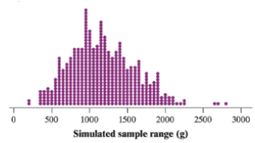
Calculation:
The middle
The middle
The middle
Graph:
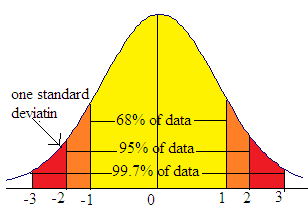
Finding the values that are 1, 2 and 3 standard deviations from the mean
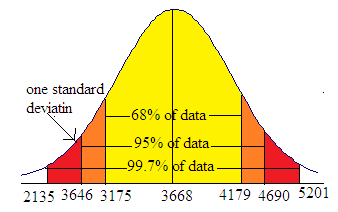
(b)
To construct: a possible graph of the distribution of birth weights for an SRS of size 5 and calculate the
(b)
Explanation of Solution
Given:
Normal distribution
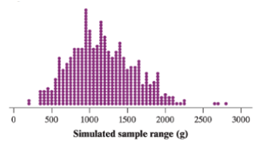
Calculation:
A simple random sample of size 5 then contains 5 data values that are roughly centred about a, while all data values are between
A possible sample of size
Graph:
Dot plot

For each given data value places a dot above the associating number on the number line.
(c)
To Explain: the value represents.
(c)
Explanation of Solution
Given:
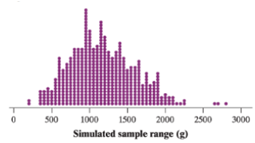
The dots is the dot plot represent the sample range of simple random samples of size
(d)
To Explain: the sample ranges an unbiased estimator of the population range and gives evidence from the graph to support the answer.
(d)
Explanation of Solution
Given:
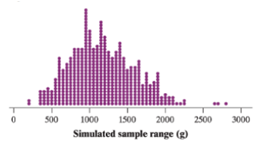
Calculation:
The middle
The middle
The middle
Thus nearly all data values are between 5201 and 2135.
The range is the difference between the maximum and minimum.
This then implies that the population range is about 3066 grams.
An estimator is called unbiased, if the centre of the sampling distribution of the estimator is equal to the corresponding population parameter.
In the dot plot, it is observed that all sample ranges are smaller than the population range of 3066 grams. This then implies that the centre of the sampling distribution of the sample ranges is not the population range and thus the sample range is not an unbiased estimator of the population range.
Chapter 7 Solutions
PRACTICE OF STATISTICS F/AP EXAM
Additional Math Textbook Solutions
Essentials of Statistics, Books a la Carte Edition (5th Edition)
Statistical Reasoning for Everyday Life (5th Edition)
Introductory Statistics
Basic Business Statistics, Student Value Edition
Basic Business Statistics, Student Value Edition (13th Edition)
 MATLAB: An Introduction with ApplicationsStatisticsISBN:9781119256830Author:Amos GilatPublisher:John Wiley & Sons Inc
MATLAB: An Introduction with ApplicationsStatisticsISBN:9781119256830Author:Amos GilatPublisher:John Wiley & Sons Inc Probability and Statistics for Engineering and th...StatisticsISBN:9781305251809Author:Jay L. DevorePublisher:Cengage Learning
Probability and Statistics for Engineering and th...StatisticsISBN:9781305251809Author:Jay L. DevorePublisher:Cengage Learning Statistics for The Behavioral Sciences (MindTap C...StatisticsISBN:9781305504912Author:Frederick J Gravetter, Larry B. WallnauPublisher:Cengage Learning
Statistics for The Behavioral Sciences (MindTap C...StatisticsISBN:9781305504912Author:Frederick J Gravetter, Larry B. WallnauPublisher:Cengage Learning Elementary Statistics: Picturing the World (7th E...StatisticsISBN:9780134683416Author:Ron Larson, Betsy FarberPublisher:PEARSON
Elementary Statistics: Picturing the World (7th E...StatisticsISBN:9780134683416Author:Ron Larson, Betsy FarberPublisher:PEARSON The Basic Practice of StatisticsStatisticsISBN:9781319042578Author:David S. Moore, William I. Notz, Michael A. FlignerPublisher:W. H. Freeman
The Basic Practice of StatisticsStatisticsISBN:9781319042578Author:David S. Moore, William I. Notz, Michael A. FlignerPublisher:W. H. Freeman Introduction to the Practice of StatisticsStatisticsISBN:9781319013387Author:David S. Moore, George P. McCabe, Bruce A. CraigPublisher:W. H. Freeman
Introduction to the Practice of StatisticsStatisticsISBN:9781319013387Author:David S. Moore, George P. McCabe, Bruce A. CraigPublisher:W. H. Freeman





